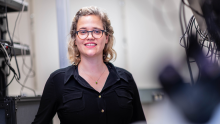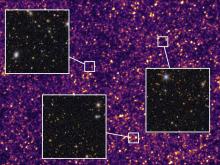An international team of scientists including UBC astronomer Ingrid Stairs has discovered a promising way to fine-tune pulsars into the best precision time-pieces in the Universe.
The discovery could give astronomers a new tool to study the powerful gravitational forces that shaped the universe.
Pulsars--incredibly fast spinning collapsed stars--have been studied in great detail since their discovery in 1967. The extremely stable rotation of these 'cosmic clocks' has enabled astronomers to discover the first planets orbiting other stars and provided stringent tests for theories of the Universe.
However, until now, slight irregularities in their spin have puzzled scientists and significantly reduced their usefulness as precision tools.
Astronomers have observed that pulsar spin rates slow very gradually over time. The team, led by the University of Manchester's Professor Andrew Lyne, used decades-worth of observations to determine that pulsars actually exhibit two different rates of spin change, not one as previously thought, and switch between them abruptly. The team also discovered that these variations are associated with changes in the pulsar’s appearance that can be used to ‘correct’ for the shifts.
"Humanity's best clocks all need corrections, perhaps for the effects of changing temperature, atmospheric pressure, humidity or local magnetic field,” says Lyne. “Here, we have found a potential means of correcting an astrophysical clock."
The findings were reported today in Science.
The discovery makes pulsars better tools for detecting gravitational waves--mysterious, powerful ripples which have not yet been directly observed, although widely believed to exist. The direct discovery of gravitational waves, which cause the distortion of space, could allow scientists to study the Universe shortly after the Big Bang and other violent events such as the merging of super-massive black holes.
"Many observatories around the world are attempting to use pulsars in order to detect the gravitational waves that are expected to be created by super-massive binary black holes in the Universe,” says Stairs. “With our new technique we may be able to reveal the gravitational wave signals that are currently hidden because of the irregularities in the pulsar rotation."
"These changes are associated with a change in the shape of the pulse, or tick, emitted by the pulsar,” says George Hobbs of the Australia Telescope National Facility. “Because of this, precision measurements of the pulse shape at any particular time indicate exactly what the slowdown rate is and allow the calculation of a ‘correction’. This significantly improves their properties as clocks."
The scientists made their breakthrough using the 76-m Lovell radio telescope at the University of Manchester's Jodrell Bank Observatory. "These exciting results were only possible because of the quality and duration of the unique Lovell telescope pulsar timing database," says Ben Stappers of the University of Manchester.
As stated by Professor Michael Kramer of the Max Planck Institute for Radioastronomy and the University of Manchester: "These results give a completely new insight into the extreme conditions near neutron stars and also offer the potential for improving our already very precise experiments in gravitation."
Musqueam First Nation land acknowledegement
We honour xwməθkwəy̓ əm (Musqueam) on whose ancestral, unceded territory UBC Vancouver is situated. UBC Science is committed to building meaningful relationships with Indigenous peoples so we can advance Reconciliation and ensure traditional ways of knowing enrich our teaching and research.
Learn more: Musqueam First Nation
Faculty of Science
Office of the Dean, Earth Sciences Building2178–2207 Main Mall
Vancouver, BC Canada
V6T 1Z4


